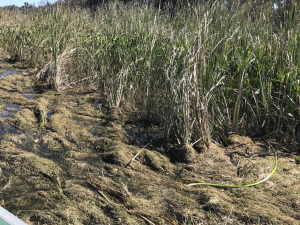This blog was written by Kelli Gladding, a biological scientist for the UF/IFAS Center for Aquatic and Invasive Plants.
Invasive aquatic plants negatively impact the success of native plant populations. As a biological scientist, one of the systems I visit frequently is Lake Cypress, located in South Central Florida in Osceola County. Lake Cypress is part of the Kissimmee Chain of Lakes (KCOL) between Lake Tohopekaliga and Lake Hatchineha.

On October 24, 2023, I observed hydrilla (Hydrilla verticillata) that had been uprooted from the lake bottom and appeared to have been washed over the top of the native emergent plants, Southern bulrush (Schoenoplectus californicus) and the Kissimmee grass (aka- Knot grass, (Paspalidium geminatum). There was approximately a 12-foot-wide band of hydrilla over the top of the bulrush stretching >1,000 feet in length along the shoreline, pushing the tall reed-like leaves down into the water of the bulrush and smothering this beneficial native species.
Hydrilla is a non-native and invasive weed and has invaded Lake Cypress since the mid 1980’S. Hydrilla is mostly thought of as a weed that can outcompete native submersed aquatic vegetation (SAV- plants that grow entirely under the surface of the water). In the spring of 2023, the dominant SAV was the native Illinois Pondweed (aka- peppergrass, (Potamogeton illinoensis) with Eel grass (Vallisneria americana) over the summer, the hydrilla quickly grew and outcompeted the native SAV and has currently filled in the lake with over 3,000 acres across the lake.

This isn’t the only occasion when I have observed this phenomenon. In January of 2022, following a strong windstorm on Lake Apopka, the Orange County side of the lake, hydrilla was observed to have been uprooted and smothering several emergent native plants such as Bulrush, Kissimmee grass and Cattails for thousands of feet along the shoreline. While the hydrilla had been uprooted in Apopka, the native SAV, Eel grass was still rooted under the water’s surface near the Kissimmee grass. There is an obvious short-term impact on the native emergent plant species by thinning the overall abundance but the longer-term impacts of hydrilla smothering native emergent plants still needs to be researched.
It’s difficult to draw long-term conclusions from these observations but they are interesting, nonetheless. To see an invasive plant, that typically causes negative impacts from below the surface, be just as problematic above the waterline can be concerning. Have you seen something similar? Let us know!
This blog post was written by Kelli Gladding, UF/IFAS CAIP biological scientist. Questions or comments can be sent to the UF/IFAS CAIP communications manager at caip@ifas.ufl.edu. Follow UF/IFAS CAIP on Instagram. Subscribe for more blogs like this one.
UF/IFAS Center for Aquatic and Invasive Plants. Turning Science Into Solutions.
Did you find this post helpful? Click the heart below!
 8
8
